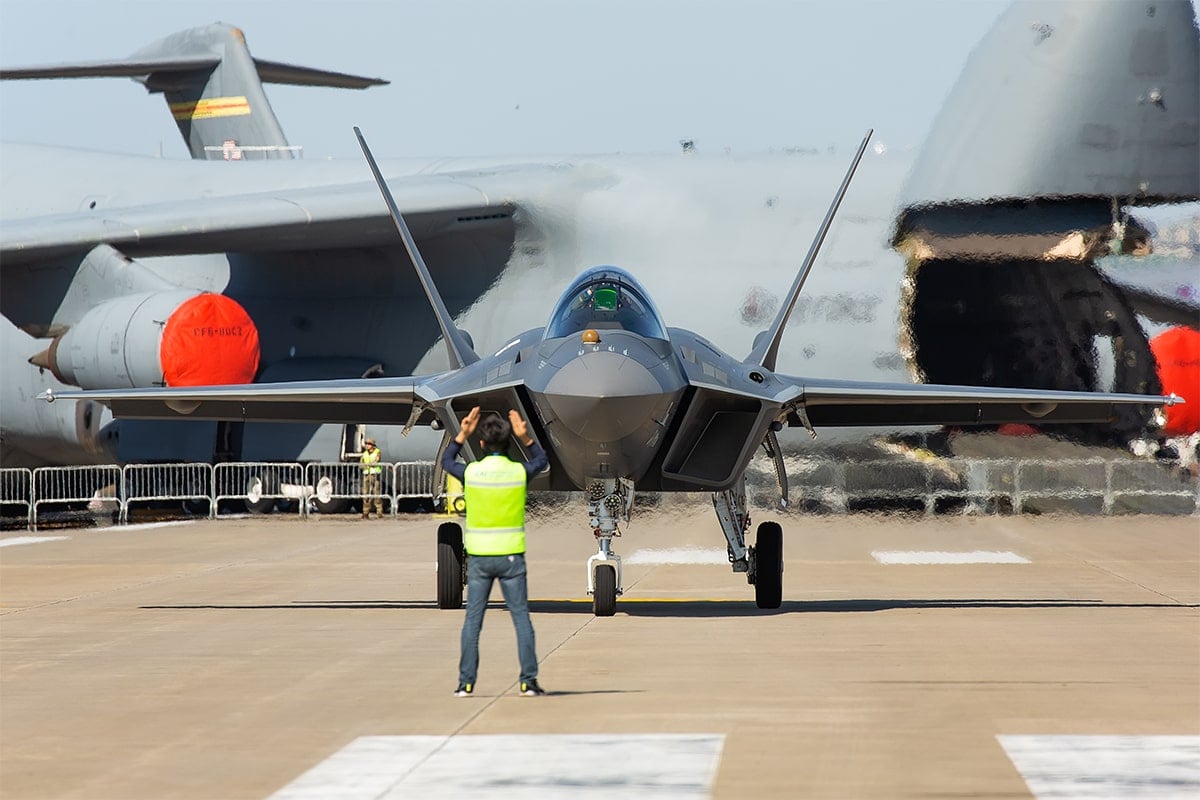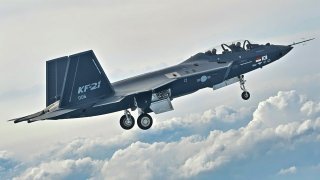KF-21 Boramae: Could This Be the Cheap Version of the F-35?
The outward similarities between the KF-21 and the F-35 raise some questions, namely, is the KF-21 just a knock-off F-35?
With an introduction planned for 2026, the KF-21 Boramae fighter (formerly known as the KF-X), is a multi-national effort to create a modern airframe with stealth capabilities.
While the KF-21 is not a true fifth-generation fighter, the new jet is being billed as stealthier than any existing fourth-generation fighter.
The KF-21 looks like a fifth-generation fighter – a specific fifth-generation fighter: the Lockheed Martin F-35 Joint Strike Fighter.
The outward similarities between the KF-21 and the F-35 raise some questions, namely, is the KF-21 just a knock-off F-35?
KF-21: An International Partnership
The KF-21 is a collaborative program between South Korea, Indonesia, and private stakeholders.
South Korea has taken the lead, holding 60 percent of the program’s shares. Indonesia, meanwhile, holds 20 percent.
The remaining 20 percent belong to private stakeholders, including Korea Aerospace Industries (KAI).
International collaborations, to create fighter programs, are not unheard of. A collection of European stakeholders are currently working together to create the Future Combat Air System, a proposed sixth-generation fighter that is slated to replace Rafales, Typhoons and Hornets around 2040.
But typically, fighter programs are developed in-house, with export and foreign licensing occurring after the fact. So, for South Korea to loop in the Indonesians does make the KF-21 program somewhat notable.
Time For an Update
The KF-21 will be a multirole fighter, built to replace South Korea’s aging fleet of F-4 Phantoms (first flight May 1958) and F-5 Tigers (first flight July 1963).
The F-4 and F-5 are both venerable fighters, both ahead of their time perhaps, but that time was half a century ago.
The Americans (who developed both airframes) phased out the F-4 and F-5 long ago – in favor of now-aged fourth-generation fighters like the F-14, F-15, F-18, and F/A-18.
And South Korea is suddenly feeling pressure to modernize its fighter fleet – pressure from the west, where China is updating its fighter fleet and generally modernizing its warfighting capabilities.

Indeed, China is amidst one of human history’s greatest shipbuilding sprees. And China is working to develop ultra-modern aviation tech, too, most notably the Chengdu J-20 fighter and Xi’an H-20 bomber. The new ships and the new jets are the tools behind an emboldened Chinese foreign policy that increasingly lays claim to disputed territories through the Indo-Pacific.
South Korea has cause to be nervous; a neighbor invaded and occupied South Korea just two generations ago. And South Korea is still technically at war with North Korea – a secretive regime that enjoys the backing of China.
So, South Korea, situated firmly within northeast Asia, which is apt to become the globe’s most important geopolitical region, undoubtedly feels strong incentive to keep their fighter fleet current.
The Specifications on the KF-21
The KF-21 is a multirole fighter with stealth capabilities. How stealthy will the new jet be?
The KF-21’s stealth capabilities are expected to be superior to the Dassault Rafale and Eurofighter Typhoon, yet inferior to the Lockheed Martin F-35. So, something like a fourth-generation-plus aircraft with respect to stealth.

Holding back the KF-21’s stealth capabilities, no doubt, is the lack of an internal weapons bay. The F-22 and F-35, two bona fide fifth-generation fighters, reduce their radar cross section through the use of an internal weapons bay.
By keeping weapons store internally, within the smooth and stealthy surfaces of the jet’s fuselage, an internal weapons bay is far superior – stealth-wise – to storing weapons on external hardpoints where the angular and jutting surfaces of missiles, rockets, and bombs can increase a jet’s radar cross-section.
While designing the KF-21, South Korea paid particular attention to an existing American fighter: the F-16 Fighting Falcon. According to the Weapon Systems Concept Development and Application Research Center at Konkuk University, the South Koreans needed to create an airframe that was superior to the F-16 – with 50 percent greater combat range, a 34 percent longer lifespan, and superior avionics, radar, data link abilities, et cetera.
The finished KF-21 will rely on two General Electric F414-GE-400k engines, providing 22,000 pounds of thrust each (with afterburner engaged). The jet will be capable of reaching Mach 1.81 and operating within a range of 620 miles.

The first KF-21 prototype was unveiled on April 9th, 2021. The KF-21 embarked upon its maiden flight that July, bearing the flags of South Korea and Indonesia, taking a 33-minute test flight from Sacheon Airbase.
Mass production of the KF-21 is slated to begin in 2026. Until then, six protypes are expected to conduct about 2,200 flight tests.
The production schedule is expected to include 40 Block-1 jets that will be restricted to air-to-air responsibilities; then, in 2028, an additional 80 Block-2 jets are expected, which will also be capable of adding air-to-ground capabilities.
About the Author
Harrison Kass is a prolific defense and national security writer with over 1,000 articles published. An attorney, pilot, guitarist, and minor pro hockey player, Harrison joined the US Air Force as a Pilot Trainee but was medically discharged. Harrison holds a BA from Lake Forest College, a JD from the University of Oregon, and an MA from New York University. Harrison listens to Dokken.
All images are Creative Commons.


